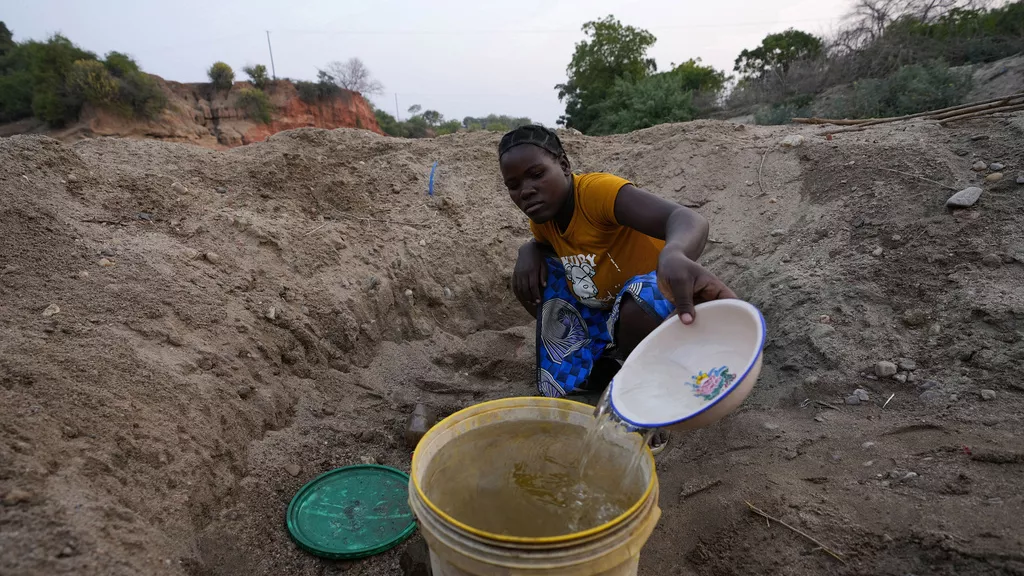Southern Africa Faces Severe Hunger Crisis Amid El Niño-Induced Drought
3 min read
A woman scoops water from a hole she has dug in a dried up riverbed in Lusitu, Zambia, Wednesday, Sept. 18, 2024.

A woman scoops water from a hole she has dug in a dried up riverbed in Lusitu, Zambia, Wednesday, Sept. 18, 2024.
Southern Africa is grappling with its worst hunger crisis in decades, affecting over 27 million people, as months of drought linked to the El Niño weather phenomenon wreak havoc across the region. The United Nations’ World Food Program (WFP) has warned that the situation could escalate into a “full-scale human catastrophe.”
Countries including Lesotho, Malawi, Namibia, Zambia, and Zimbabwe have declared national disasters in response to the drought and the resulting food shortages. The WFP estimates that around 21 million children in southern Africa are now suffering from malnutrition due to widespread crop failures.
In southern Africa, tens of millions of people depend on small-scale, rain-fed agriculture for both food and income. As the naturally occurring El Niño has led to below-average rainfall across the region, the impact has been worsened by climate change and rising global temperatures.
“This is the worst food crisis in decades,” said WFP spokesperson Tomson Phiri. “October marks the beginning of the lean season in southern Africa, and conditions are expected to deteriorate further each month until the next harvests in March and April. Crops have failed, livestock have died, and many children are fortunate to receive even one meal per day.”
The countries that have declared drought-related disasters are urgently seeking international aid. Phiri also noted that neighboring Angola and Mozambique are facing severe impacts, illustrating the widespread nature of the drought’s effects.
“The situation is dire,” Phiri emphasized, adding that the WFP requires approximately $369 million to deliver immediate assistance but has only received about one-fifth of that amount due to a lack of donations. In response to the escalating crisis, the WFP has begun providing food aid and other vital support at the request of various governments.
The humanitarian crisis in southern Africa comes at a time when global aid needs are skyrocketing, with urgent requirements for assistance also in Gaza, Sudan, and other regions. Other organizations, such as the United States Agency for International Development (USAID), have labeled the ongoing drought in southern Africa as the most severe in a century. Between January and March, the drought obliterated vast areas of crops, leaving millions without sufficient food.
El Niño, a climatic event that typically warms parts of the central Pacific, produces varying weather impacts worldwide. The latest El Niño emerged in mid-2022 and concluded in June 2023, contributing to extreme weather patterns, including heatwaves and unprecedented rainfall deficits in southern Africa.
As a direct consequence of the drought, food prices have surged in many affected areas, compounding the suffering of vulnerable populations. Furthermore, the drought has precipitated other severe challenges. In Zambia, for instance, the reliance on hydroelectric power from the Kariba Dam has resulted in significant energy losses, leading to prolonged power outages that last hours, if not days. Zimbabwe, sharing the dam, is similarly affected by power shortages.
In response to the escalating hunger crisis, authorities in Namibia and Zimbabwe have resorted to culling wildlife, including elephants, to provide meat for starving communities. Such drastic measures highlight the severity of the situation and the lengths to which countries must go to address food shortages.
Experts warn that sub-Saharan Africa is among the regions most vulnerable to climate change, largely due to its reliance on rain-fed agriculture and natural resources. Many livelihoods in Africa hinge on stable climatic conditions, yet poorer nations often lack the resources to implement climate-resilient measures.
As the crisis deepens, international attention is crucial to mobilize support for the millions suffering from the effects of drought in southern Africa. Without timely intervention and sustained assistance, the situation is likely to worsen, threatening the lives and futures of countless individuals and families in the region.
The world watches as southern Africa battles this unprecedented humanitarian crisis, highlighting the urgent need for collaborative efforts to combat the underlying causes of climate vulnerability and food insecurity.